The Birth Place of Greece...
On the eve of the year 1900, Sir Arthur Evans discovered the Minoan Palace Knossos and what was to become the Minoan civilization. Settled upon the isle of Crete and named after the mythical Cretan King Minos, Evans discovered both an influential civilization with extensive trade routes covering such vast territories as Turkey, Cyprus, Egypt, Afghanistan and Scandinavia, and the birthplace of ancient Greece as well.
The Palace of Knossos
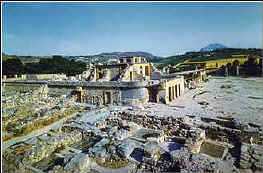
The palace of Knossos and the Minoan Civilization thrived in the Bronze age (roughly 3,000 BC) within the Aegean. The product of early Phoenician settlement upon Crete, the Minoans hosted three great palaces known as Knossos, Kato Sakro (also known as Phaestos), and Mallia. Of the three great palaces, none surpasses the exquisite palace of Knossos.
The palace of Knossos was a multi-storied building, spanning five and a half acres of land, and housed not only the King of the Minoan State, but also his advisors, his trade goods, and several craftspeople. In addition, the palace held within its walls a central court yard, numerous rooms and corridors, a throne room, large baths, a large courtyard, enormous storerooms, some craft workshops, the administrative chambers, and an intricate plumbing system. The palace itself, however, was not indestructible to the ravages of time or change. Renovated, one renovation atop of the other, the palace changed as the administrative center of Minoan civilization grew, but it was always built according to a plan. Outside of the palace of Knossos were many houses, a smaller palace, and some craft workshops. Important to the status and power of the Minoan state were the palace's trade routes, via the extensive stream systems of Crete, the intricate roads, and most importantly the naval strength of the Minoan civilization itself. Where the Egyptians feared the treacherous seas of the Aegean and Mediterranean, the Minoans dwelt in power. The city of Knossos did not build city walls for protection. The trade routes from Knossos established communications and goods from such diverse areas as Turkey, Cyprus, Egypt, Afghanistan, and Scandinavia. Goods traded with Knossos were copper, ivory, amethyst, lapis-lazuli, carnelian, gold, amber, among other important commodities.
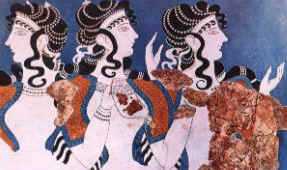
The palace of Knossos was only destroyed twice in its history, once from fire (roughly in 1700 BC) and a wall collapse, the second and later destruction from a major earthquake which ravaged Crete. The later earthquake not only brought destruction to Knossos, but to both Kato Sakro and Mallia as well. These events, however, were not to end Minoan civilization. Not until 1450 BC was the end of Minoan Civilization realized. The final collapse of the Minoan state remains a half-solved mystery. Two factors are thought to have contributed to the end of the Minoan: the possible eruption of the volcano Thera and the rise of the Mycenaean civilization upon Crete.
The Myth of Knossos and King Minos
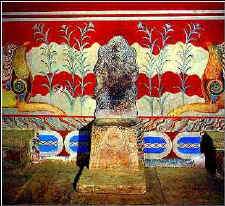
Greek mythology immortalized Crete and Knossos with its legends. According to the Greeks, Mount Ida which is found on Crete, was the location where Rhea, the Earth Mother, gave birth to Zeus. He was fed by nature a diet of honey and goat’s milk, was tended by a group of nymphs, and was guarded by an army of youths against his father, Cronus, whose reign was threatened by Zeus’ existence. Zeus fathered a son, Minos, who became the King of Knossos, Crete, and the rest of the Aegean.
King Minos' son, Androgeus, according to the myth, was a strong, athletic youth. He was sent to represent Crete in the Athenian games and was successful in winning many events. The King of Athens murdered Androgeus out of jealousy. When Minos heard about the death of his son, he was enraged and deployed the mighty Cretan fleet. The fleet took Athens and instead of destroying the city, Minos decreed that every nine years Athens was obligated to send him seven young men and seven virgin women. King Minos threw them into a labyrinth where they were sacrificed to the Minotaur. Theseus, the Athenian King’s son, volunteered to be one of the seven sacrificial young men with the intention of killing the Minotaur and ending the suffering of Athens. If he succeeded in his mission, he told his father that he would raise white sails instead of the black sails on his ship. Theseus arrived at the palace of the Cretan King, and with the help of Minos’ daughter, Ariadne (who fell in love with Theseus), he was able to kill the Minotaur. In returning home, Theseus, in his excitement, forgot to change the sails on the ship from black to white. The King of Athens saw the black sails. Thinking that his son’s plan failed and that Theseus was dead, the king flung himself into the sea and died.
The remains of the Minoan Civilization
What remains of Minoan culture, is a half understood mystery. The language of the Minoans, known as 'Linear A', has never been deciphered. The lack of a decipherable language has made attempts at a definite description of Minoan life and culture nearly impossible. However, what archeologists have learned about Minoan life comes from the exceptional art, architecture, and tool artifacts of the Minoans.
Minoan life was ruled by a King and nobles who governed all aspects of Minoan life, including trade, art, and religion. The government of the Minoan was theocratic, and the religion of Minoan was matriarchal and centered around the worship of several goddess and high priestesses. Accordingly the Minoans took part in many ritual acts, including "bull leaping". Bull leaping involved mid-air leaping, onto the back of a charging bull.
Stratification in Minoan Culture consisted mostly between Nobel, Citizen, and Slave. However, the stratification of the Minoan appears to have been minimal. Slaves were said to have been treated fairly by their masters and in the religious spectrum the only act slaves could not partake in was bull leaping. Additionally, there were no acts which were restricted from women (that we know of). As seen on many of the beautiful fresco's often times the women worked along side the men. Similarly, archeologists surmise that due to a lack of elaborate burials, (like those seen in Ancient Egypt) the king and nobles were not kept in the highly structured position often kept by state civilizations of its type.
The Rise of the Myceneans
As Minoan trade routes expanded across the Mediterranean, contact with mainland Greece became inevitable. The Myceneans occupied the city of Mycenea, which eventually became a major trading center in the Aegean. This was evidenced by the Mycenean records, written in Linear B (a language based directly upon Linear A). Trade and commerce with the Minoans was initially peaceful. It wasn't until the year 1450 BC when the Myceneans invaded Crete and took many of its palaces as well as Knossos. After taking Knossos, Crete was ruled for 50 years by the Myceneans, until a natural disaster left the Palace of Knossos in ashes. However, the events leading to the fall of Knossos remain strongly in debate. What is evidenced by many of the Mycenean artifacts, is the integration of Minoan artistic elements into Mycenean art. However, though Minoan and Mycenean art have many elements in common, there are also many differences which divide both civilizations. If the differences between civilizations were to be based on language, the Myceneans' were the first Greek speaking people who lived on Mainland Greece. Further, in the traditional sense, it is with the works of Homer that the first actual readable Greek literature (outside of trade and stock manuscripts written in linear B) attempt to tell the actual history of its people (even though Homer wrote them many years after the end of the Mycenean age, and classical Greek writing was not fully evolved until well into the classical age). What remains obvious from such a controversy is that too little is known of Minoan Crete due to the language barrier and the controversy which shall perhaps remain until Linear A is translated.
The Mycenean
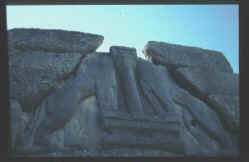
Where Minoan Civilization lived in apparent matrilineal, theocratic harmony, the Myceneans were a different political complex altogether. The Myceneans had a theocracy consisting of a king, warrior/religious aristocracy, and subjects.
Similar to Ancient Egypt, the king was seen by his subjects as an all powerful individual, so much so that he was given the name wanax (a title which was also given to the divine, however, there are no indications that the divine status was inferred to the king). Below the wanax were a number of officials with specific titles, who ruled over aspects of religion and military life. These officials and the king held an extensive division of labor over their subjects. Political and economic power was retained through the palace of the king, and scribes kept detailed records of the king's possessions, taxes, and other inventories written in Linear B.
With the fall of Minoan Crete, the Myceneans were allowed avenues of trade unopened to them before. Quickly Mycenean trade expanded to Cyprus, Egypt, and well into Asia Minor. Traded goods included perfumed oils, olive oil, wine, art, ivory, plaques, pottery, bronze objects, gold, copper, tin, spices, elephant tusks, and dye. In addition to the renewal of trade, the Myceneans (after taking Crete) expanded to form cities in Athens, Thebes, Tiryns, and Pylos. In many of the cities, fine citadels were created along with heavily fortified city walls, such as those found at Pylos and Tiryns.
The fall of the Mycenean Civilization took place within 1300 and 1000 BC, and rather than have attributed its downfall to an outside influence, Mycenea fell by its own hands. It is surmised (though disputed), that the fall of the Myceneans took place as a result of internecine wars between its own kingdoms, historically known as the Trojan Wars. The pattern of rivalry between kingdoms is evidenced in such great works as Homer's The Illiad, and continued to be a pattern repeated throughout the history of Ancient Greece. Eventually, with the fall of the Mycenean, Ancient Greece went through what is commonly known as the Greek Dark Ages.
Homer
In the study of Greece, to read Homer is considered essential. It has been written by many authors of present, and spoken of in many of the universities and schools of the past that you cannot know Greece, unless you have read Homer's, The Illiad, and The Odyssey, and even his other poetic works. Homer's work is still considered a main staple to the literary library of any student, and in some regards, his work is used as historical evidence of the life within Bronze Age, or Mycenean Greece.
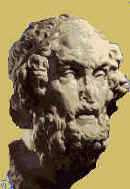
Little is known of who Homer actually was, and by and large, many sources dispute whether biographical information is actually important toward a scholarly understanding of his literary works. In part, this is due to several factors within his work which are for the most part historical discrepancies relating to the time Homer's works were supposed to have been written and the archeological evidence found from excavated sites in the present day. In addition, there continues to be debate between scholars as to whether or not Homer was the true and only writer of his works. The supposition that it was perhaps a series of bards who wrote upon the works of Homer, and who created a tradition based upon his work, still remains a viable theory, though largely debated as improbable. What remains clear about Homer's work is that in the scheme of Ancient Greece, one cannot be free from his works, but at the same time, putting his work into a historical perspective remains largely a matter of debate.
Partially, the problems of context which relate to Homer's writings can be related to the reliance of Ancient Greek bards on an oral tradition. In the case of Homer, there is an obvious change from a completely oral tradition, toward an actual written script. This change meant several things to Homer's writing which remain in dispute. First, it is obvious that his original writings were as a result of spoken work, and were easily open to editing in later dates. Second, the oral tradition allows for embellishment of events and much more story telling leeway to achieve the desired effect of awe on a given audience; which in turn allows for the story to change from audience to audience. In these regards, the works of Homer cannot be thought of as actual historical works of the Trojan Wars and Bronze Age Greece (for example, historical discrepancies such as Iron axes found in Bronze Age Greece are written of in Homer's works), but more so as historical works which tell about the transition between bardic traditions, and further, the literary style of the time. Taken in this context and regard, Homer's works are utter masterpieces.
The two works which have borne Homer into the realm of literary immortality are The Illiad and The Odyssey. Though Homer wrote many works, these two remain the staples of his literary body. Though the two works are considered masterpieces, and are thought to compliment one another, from the perspective of genre they are as different as night and day. The Odyssey is written in the format of a fantastic novel and catalogs the adventure of Odysseus and his quest to return to his native land of Ithaca after many years of being gone. With its many subplots and dynamic stories, it is a master work of the adventure novel writing, and well worth the great read. In contrast, The Illiad is a work which depicts the ravages of war during the Greek Siege of Troy nearing the end of the Bronze Age period. The work itself is considered by many to be quite graphic and details many of the sieges and internecine wars which rippled through the landscape of Greece during the end of the Bronze Age. The graphic and power of the Illiad was best written by the author Peter France, "If you read it, you will be changed by it".
The Greek Dark Ages


The downfall of the Mycenaean age came swiftly and was due to multiple causes. Upon the advent of its destruction, the Iron Age Dorians invaded the Greek peninsula from the north (estimated time 1200BC to 1100BC). Atop the invasion, civil war also entered mainland Greece, directly following the Dorian invasion. What followed was a period known aptly as the Greek Dark Ages.
The Dark Ages lasted from 1100 BC until 800 BC, or relatively to the time of Hellenic or Classical Greece. During this time the culture of Greece dwindled. Little is known of how many cultural elements were lost during the Dark Ages, but characteristic of the Dark Age, is the gradual decimation of any urbanized culture on the Greek mainland. In addition, many of the elements left from Mycenaean culture were destroyed, and writing, which had been so important during the Mycenaean, was not practiced. The great trading empire which had begun with the Minoans and was inherited by the Mycenaean's, was destroyed in the Dark Ages. Trade with Asia Minor, the Middle East, and Egypt stopped entirely. Artistic elements of the time portray simple geometrical designs and patterns.
During the Dorian invasions, which occurred continually on mainland Greece and down through the Peloponnese, entire villages were abandoned, and migrations occurred toward the islands of the Aegean. Dorian rule in many cities and villages was of either two types. The first type consisted of the Dorians entering a city and assimilating themselves into it. The second type, as in the case of Sparta and Argos, created an upper caste which consisted exclusively of themselves, leaving the lower caste entirely made of native citizens--a life of serfdom. What followed the initial invasion and rule of the Dorians and the Greek civil war, (within the years of 1200BC to 750BC) was a shift in lifestyle, centered around a moderately sedentary agricultural lifestyle. However, though Greek civilization had hit its lowest point, the idle time of 450 years allowed the Greeks to rediscover urbanized culture, which in turn created the tales and cultures of Greece as they are classically and popularly known.
The Re-emergence of Greece
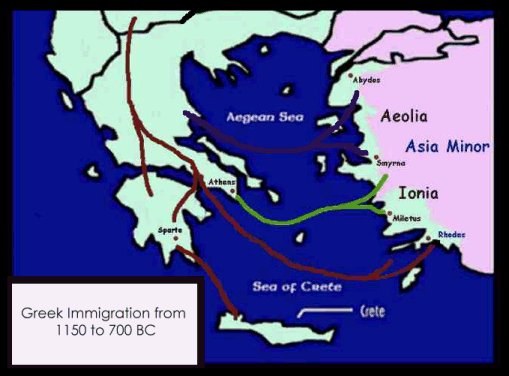
The re-emergence of Greek culture has been attributed to many variables, most of which appear to have taken ages and many immigrations to create. The migration to the islands and lands surrounding the Aegean led many migrants and cultures to re-establish themselves in the eastern coasts of the Aegean, and to the boot section of Italy with it's accompanying islands. Specifically, the migrations of the Aeolians and the Ionians, led to the creation of such cities as Lesbos, Miletus, Smyrn, Abydos and Rhodes. Coupled with such recent immigrations, both the Aeolians and the Ionians set up many long lasting communities, which led to a population boom, and further, to the greater proliferation of their people and traditions. In addition to the proliferation of traditions, Athens, and many other cities took to the fore in breaking free from the old monarchy government of prior ages. The change in government was mostly due to the leading families of Athens joining together to elect an individual, or archon (chief of state) for one year. The result was the gradual acceptance of an aristocratic republic.
Ultimately, the result of the Greek immigrations was a plume of independent Greek cities throughout the Aegean. Whether these immigrations were peaceful or not, the general mood of the Greeks was that they were seeking, "A home away from home," or what the Greeks called apoikia. However, trade played a great part in such immigrations, as did (obviously) the Dorian invasions. Thenceforth, from 700 BC onward the Greeks began to create a trading empire throughout the regions of the Mediterranean, holding specific dominion over the coasts of the Aegean Sea. This radical shift in power within the Aegean was ultimately aided by the fall of other empires throughout the area, such as the diminishing kingdoms of Egypt and the Hittite Empire, which had all but been destroyed by the time of the rise of Greece. In addition, many of the other menaces which were to plague the Greeks in the future were not yet formed. In particular, the Roman Empire was still heavily under Etruscan rule, and the Persians were still in the formative stages of their own cities. What is certain of the Greeks is that they occupied an unusual place in history where, coupled with relative peace and a healthy trade, they began to take the shape of what is known now as Classical Greece and to dominate the Aegean Sea.